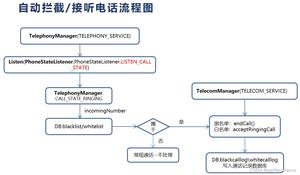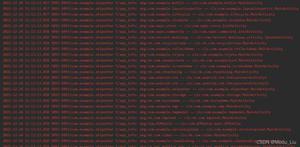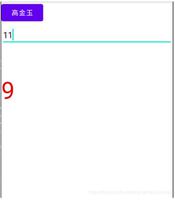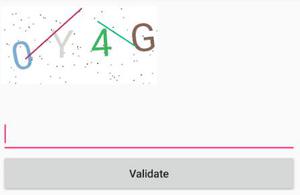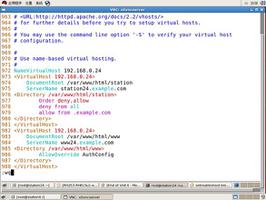Android使用代码动态生成界面
我们最常用使用XML来编写Android应用程序的UI,这样的好处是方便快捷可视化,而且维护和修改特别容易,但是它是静态的。如果我们要做的程序的界面是固定的,用XML固然是最好的选择,但是如果我们需要动态、灵活地控制UI,使用代码来动态生成UI无疑使最好的办法。
在XML中,我们使用的五大布局:LinearLayout(线性布局)、RelativeLayout(相对布局)、TableLayout(表格布局)、AbsoluteLayout(绝对布局)和FrameLayout(帧布局)在Android中也有对应的类来表示。
举个例子,我现在需要显示一个表格,表格的行数和列数及其内容都不确定,如果在XML中,这是不可能实现的。
先给大家看一下成品:(下面的代码只给大家展示如何实现,表格里面的内容忽略)
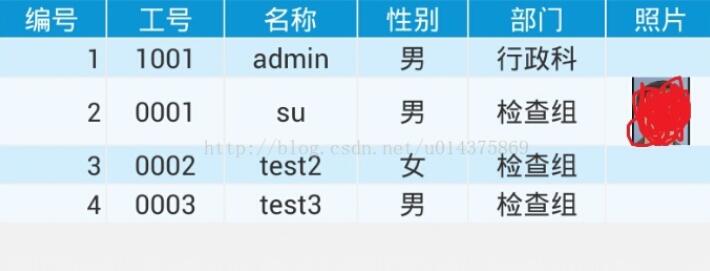
首先,新建一个不带任何控件的XML文件
<?xml version="1.0" encoding="utf-8"?>
<LinearLayout xmlns:android="http://schemas.android.com/apk/res/android"
android:layout_width="match_parent"
android:layout_height="match_parent"
android:orientation="vertical" >
<TableLayout
android:id="@+id/tableLayout"
android:layout_width="match_parent"
android:layout_height="wrap_content" >
</TableLayout>
</LinearLayout>
在代码中新建一个TableLayout:
// TODO 显示表格信息
private void displayRegeditedInfo()
{
Iterator
iterator = iterable.iterator();
ICells
iCells = GlobalVariable.manager
.createPersonDataCells(IInspectionManager.CS_PERSON_LIST_CELLS);
boolean flag = true;// 标题栏为true,内容栏位false
int colorChange = 1;// 用来判断单双行,以显示不同的颜色
TableLayout tableLayout = (TableLayout) findViewById(R.id.tableLayout);
tableLayout.setStretchAllColumns(true);
tableLayout.setShrinkAllColumns(true);
while (iterator.hasNext())
{
// 行的样式
TableRow.LayoutParams params = new TableRow.LayoutParams(
ViewGroup.LayoutParams.WRAP_CONTENT, ViewGroup.LayoutParams.MATCH_PARENT);
if (flag)// 首先显示表格的标题栏,内容自己定义
{
TableRow titleRow = new TableRow(this);
for (int i = 0; i < colums; i++)// 列数
{// 列名
params.setMargins(1, 1, 1, 1);
TextView textView = new TextView(this);
textView
.setBackgroundColor(getResources().getColor(R.color.top));
textView.setTextColor(Color.WHITE);
textView.setTextSize(31);
textView.setLayoutParams(params);
textView.setText(columsName);// 列名
textView.setTextSize(30);
textView.setGravity(Gravity.CENTER_HORIZONTAL);
titleRow.addView(textView);// 把控件添加到行TableRow中
}
flag = false;
tableLayout.addView(titleRow);// 把行添加到TableLayout中
}
// 新建一行,显示每个成员的具体信息
TableRow personRow = new TableRow(this);
for (int i = 0; i < lines; i++)
{
params.setMargins(1, 1, 1, 1);
object; // 我在这里用Object代表表格显示的内容,
// Object可以是字符串、数字,也可以是照片,看你具体的定义
if (object instanceof String)
{// 字符串居中显示
TextView textView = new TextView(this);
textView.setLayoutParams(params);
textView.setTextSize(29);
if (colorChange % 2 == 1)
textView.setBackgroundColor(getResources().getColor(
R.color.second));
else
textView.setBackgroundColor(getResources().getColor(
R.color.third));
textView.setText(object.toString());
textView.setTextSize(30);
textView.setGravity(Gravity.CENTER);
personRow.addView(textView);
}
else if (object instanceof Number)
{// 数字居右显示
TextView textView = new TextView(this);
textView.setPadding(0, 0, 5, 0);// 右内边距
textView.setLayoutParams(params);
textView.setText(object.toString());
textView.setTextSize(30);
textView.setTextSize(29);
if (colorChange % 2 == 1)
textView.setBackgroundColor(getResources().getColor(
R.color.second));
else
textView.setBackgroundColor(getResources().getColor(
R.color.third));
textView.setGravity(Gravity.CENTER_VERTICAL | Gravity.RIGHT);
personRow.addView(textView);
}
else if (object instanceof byte[])
{// 显示头像
TableRow.LayoutParams params2 = new TableRow.LayoutParams(60, 75);
ImageView imageView = new ImageView(this);
if (colorChange % 2 == 1)
imageView.setBackgroundColor(getResources().getColor(
R.color.second));
else
imageView.setBackgroundColor(getResources().getColor(
R.color.third));
Bitmap bitmap = BitmapFactory.decodeByteArray((byte[]) object,
0, ((byte[]) object).length);
imageView.setImageBitmap(bitmap);
imageView.setLayoutParams(params2);
personRow.addView(imageView);
}
else
{// 空值
TextView textView = new TextView(this);
textView.setLayoutParams(params);
textView.setTextSize(30);
if (colorChange % 2 == 1)
textView.setBackgroundColor(getResources().getColor(
R.color.second));
else
textView.setBackgroundColor(getResources().getColor(
R.color.third));
personRow.addView(textView);
}
}
colorChange++;
tableLayout.addView(personRow);
}
}
还可以对整个布局、整行或某个空间添加监听事件,只需setId(int id),然后在设立监听器即可。
以上就是本文的全部内容,希望对大家的学习有所帮助,也希望大家多多支持。
以上是 Android使用代码动态生成界面 的全部内容, 来源链接: utcz.com/p/243946.html


